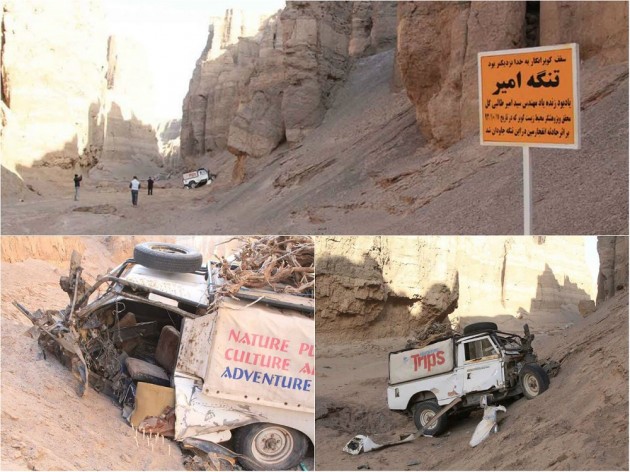Landmine Explosion in Non-Border Area Claims Another Life in Iran

These are the remains of the vehicle used by the January 2014 victim of a landmine explosion in Iran’s Lut Desert, Amir Talebi Gol, a wildlife researcher and head of a desert expedition group, who died as a result of the explosion.
According to Mehr News Agency, the victim, 32, was “an experienced mountain climber” by the name of Hamid Hashemi, who worked as a tour guide with a travel agency. The group’s car drove over a landmine on March 22, 2014, according to Mehr.
Shahdad Desert is a popular tourist destination in the Lut Desert region of Iran.
On January 1, 2014, a similar explosion claimed the life of Amir Talebi Gol, a wildlife researcher and head of a desert expedition group in the Lut Desert. Amir Talebi’s car was passing through a narrow mountain passage when it hit a landmine and exploded, killing him, a fellow wildlife researcher described in detail.
Colonel Parsa, the Command Operations Deputy of of the Southern Khorasan Province Police Force, told ISNA on January 3, 2014, “The private vehicle drove over a landmine and suffered an explosion.” But neither Colonel Parsa nor any other officials from the Iranian Police have offered any explanations about why landmines are installed in a non-border area, without any signs warning ordinary tourists of the dangers threatening them.
Many, however, believe that the landmines are planted by the Iranian police on paths believed to be used for drug smuggling convoys. In a November 2013 interview with ISNA, Police Commander Esmaeel Ahmadi Moghaddam was asked whether it was true that the police is responsible for planting landmines where it is unable to physically block the borders. Ahmadi Moghaddam told ISNA, “It is possible that explosive traps are used to set up ambushes in a tactical manner in operations, such as along the paths used by drug convoys, or the ones terrorist groups use for entering the country. But we don’t plant landmines.”
In February 2005, Iran’s Task Force Against Smuggling announced that “planting landmines is planned as one of the means for confronting smuggling in the country,” according to news sources.
Even though landmines remaining from the Iran-Iraq War have continued to take lives in Iran’s western border provinces for the past three decades, Iran is not a signatory to the United Nations’ 1997 Mine Ban Treaty, the Convention on the Prohibition of the Use, Stockpiling, Producing and Transfer of Anti-Personnel Mines and on their Destruction.






